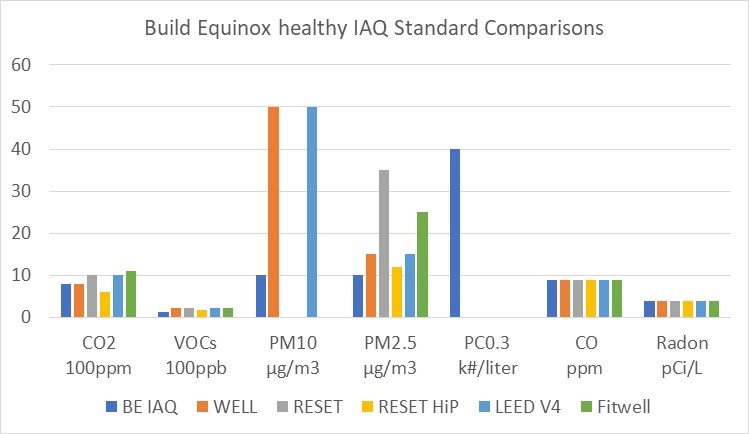Comparing Build Equinox Healthy IAQ Standard to Other Standards
Build Equinox defines healthy air quality based on research encompassing how the air we breathe affects our health and our performance. We began development of CERV smart ventilation technology in 2008, long ago in comparison to many of today’s IAQ companies. Readership continues to grow since we started our newsletter in 2016, but our message has stayed the same. Our mission: development of technologies that improve health and well-being in sustainable and energy efficient manners.
Indoor air quality data from our test chamber, homes and many other indoor environments since 2010, when first generation CERV units were deployed, is the most comprehensive, continuous monitoring of indoor environments we are aware of. Our research data stretches across all North American climate zones, and provides the foundation for Build Equinox’s automated indoor air quality management technologies, aka “smart ventilation.” CERV2 (low occupant density indoor environments such as homes and offices) and CERV-1000 (high occupant density indoor environments such as classrooms) provide peace-of-mind, allowing us to enjoy life instead of worrying about pollutants.
Over the past five months we have presented articles on Build Equinox healthy Indoor Air Quality Standard:
• January: Introduction of Build Equinox healthy IAQ Standard
• February: Carbon Dioxide < 800ppm criteria
• March: total VOC < 125ppb criteria
• April: PM10 < 10µg/m3 and PC0.3 < 40,000#/liter criteria
• May: Carbon Monoxide < 9ppm and Radon < 4pCi/liter criteria
Build Equinox healthy Indoor Air Quality Standard (BE IAQ Standard) defines healthy indoor environments based on human pollution of indoor environments. By effectively managing human pollutants, other pollutant sources are also managed. When one of our criteria are exceeded relative to other categories of human-related pollutants, we know additional action must be taken to control those pollutants. Fortunately, CERV2 and CERV-1000 technologies have the capabilities to manage those non-human human sources such as wildfire smoke, indoor chemical emissions, and airborne microbes.
Our healthy indoor air quality standard is not a certification standard, but guidance to define air quality conditions one should strive for in all indoor environments. BE IAQ Standard, based on people and how people pollute indoor spaces, is challenging but measurable and practical.

|
Pollutant |
BE IAQ |
|||||
|
CO2 |
<800ppm |
<800ppm |
<1000ppm |
<600ppm |
<1000ppm |
<1100ppm |
|
Total VOCs |
<125ppb |
<220ppb1 |
<220ppb1 |
<176ppb1 |
<220ppb1 |
<220ppb1 |
|
PM10 |
<10µg/m3 |
<50µg/m3 |
NA |
NA |
<50µg/m3 |
NA |
|
PM2.5 |
<10µg/m3 |
<15µg/m3 |
<35µg/m3 |
<12µg/m3 |
<15µg/m3 |
<25µg/m3 |
|
PC0.3 |
<40,000#/liter |
NA |
NA |
NA |
NA |
NA |
|
CO |
<9ppm |
<9ppm |
<9ppm |
<9ppm |
<9ppm |
<9ppm |
|
Radon |
<4pCi/liter |
<4pCi/liter |
<4pCi/liter |
<4pCi/liter |
<4pCi/liter |
<4pCi/liter |
Table 1 Comparison of Build Equinox healthy IAQ Standard with other IAQ standards.
1 alternative VOC units are 500µg/m3 = 220ppb and 400µg/m3 = 176ppb
Table 1 and Figure 1 compare BE IAQ Standard against other standards. In all IAQ categories, except for RESET’s “High Performance” standard’s 600ppm for carbon dioxide, BE IAQ Standard is the most stringent…not for the sake of being the most restrictive, but marking a line in the fight against poor indoor air quality’s impact on our health and well-being based on research data. We have no problem with low CO2 levels - the closer to outdoor CO2 levels, the better! Our research, however, does not yet indicate significant differences in health, productivity, and well-being at CO2 concentrations below 800ppm.
600ppm is an increase from 40cfm/person (our current recommended ventilation level, more than twice ASHRAE’s ventilation standard) to 80cfm/person. As climate change increases outdoor CO2 to 600ppm (not a matter of if, but when… 30 years or 50 years from now), maintaining 600ppm CO2 indoors will require infinite ventilation air flow… and that’s a lot!
We do not ignore other sources of pollutants, such as formaldehyde, but discuss how effective management of human pollutants results in effective management of other pollutants. When one or more pollutant categories are out of whack relative to other categories, an investigation for the cause of should be undertaken. For example, elevated particulate mass and/or particulate count readings indicate particulate sources greater than normal human associated particulate generation are contributing to poor air quality, such as vaping, wildfire smoke, or cooking. Increased air recirculation and filtration are necessary to manage particulates during these times.
Meeting the BE healthy IAQ Standard ensures air quality for human health and wellness that exceeds other standards. Our free-to-use CERV-ICE dashboard provides first gen CERV, current CERV2, and now CERV-1000 smart ventilation system owners with the ease of online control and monitoring of their indoor air quality, coupled with downloadable access to archived data and use of our IAQ analytic tools.
We are not done improving indoor environments… stay tuned for more news of exciting developments underway in our laboratory!























